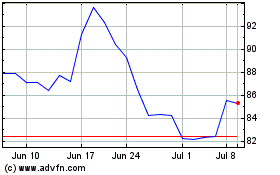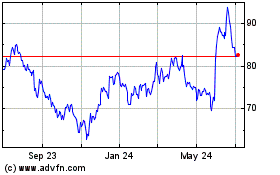By Paul Page
Sign up:With one click, get this newsletter delivered to your
inbox.
Best Buy Co. found itself in an unusual place for a retailer
during the holidays: the electronics giant saw plenty of demand for
electronics but the company couldn't keep its shelves stocked. The
supply-chain letdown triggered a surprising drop in revenue, the
WSJ's Khadeeja Safdar reports, and a warning that shortages may
continue through the first half of this year. It's a setback for a
retailer that's invested in e-commerce tools after losing customers
in recent years to Amazon.com Inc. and other price-cutting web
marketplaces. Best Buy has grown more nimble. But the new stumble
highlights how retailers are getting caught between conflicting
supply-chain demands: store owners are trying to keep inventories
lean to keep costs down, but e-commerce sales have fractured many
of the traditional forecasting tools retailers use to ensure the
right goods are in the right place to meet sales demand.
While Foxconn Technology Group talks about starting
manufacturing in the U.S. , the electronics giant is expanding its
factory footprint in southern China. Foxconn Chairman Terry Gou
pointed to the contrast as he launched construction of an $8.8
billion flat-panel screen factory in Guangzho, the WSJ's Eva Dou
reports, highlighting the high stakes and breakneck growth pace in
electronics supply chains. Foxconn has been talking for several
years about a potential flat-panel factory in the U.S. but hasn't
moved on the project. Any new factories carry extra weight for
Foxconn as they advance company efforts to move beyond contract
manufacturing and become more like Samsung Electronics Co., a
consumer brand that makes components for itself and others. That
would give Foxconn even greater weight in larger distribution
channels, from parts to final delivery, and potentially make
Foxconn's factories nodes in a more connected global network.
Harley-Davidson Inc.'s "hogs" are making noise in overseas
markets. President Donald Trump pointed to the iconic motorcycle
maker in his address to Congress this week as an American company
finding it "very hard" to do business abroad. The WSJ's Sean McLain
writes Harley-Davidson has been clearing trade barriers, however,
including 100% tariffs in at least one market, and boasts of
growing export business even as U.S. sales slip. Harley-Davidson
gets about 40% of its sales outside the U.S., in part through
nimble adjustments to meet both different customer demands and
local regulations. In India, which erects tall bars to many
overseas goods, the company has responded to tough duties and
preferences for smaller machines by setting up assembly for the
local market. In Japan, the company has tailored its bikes to the
tough pollution and noise regulations. One dealer there says the
barrier to growth isn't restrictive trade policy but an aging
population that's simply less likely to hop on a Harley.
SUPPLY CHAIN STRATEGIES
The growing food-delivery market is getting a whopper-sized
participant. McDonald's Corp. is testing home delivery in the U.S.
and Europe, the WSJ's Julie Jargon reports, as the fast-food chain
looks to meet its customers where more of them like to eat -- at
home. The move is part of a broader strategic overhaul the company
is undertaking, a response to a downturn in its business that will
include returning to its fast-food roots. It's embracing new
trends, however, by building on the rush toward food-delivery
services that's being fueled by mobile commerce and increasingly
sophisticated distribution operators. McDonald's says it's vast
network carries a big advantage: About 75% of the U.S. population
in its top five markets live within 3 miles of a McDonald's, the
company says, allowing the company to give its customers what they
want -- food that's fast and cheap.
Shipping a Kusama sculpture, it turns out, is something of an
art. The opening of an exhibit of works by the Japanese artist
Yayoi Kusama in New York this week caps an ambitious and intricate
shipping operation, WSJ Logistics Report's Jennifer Smith writes,
involving several transportation modes and some very, very delicate
handling. That's because the centerpiece of the "Guidepost to the
New World" exhibit is 11 cast-aluminum sculptures, one of them
nine-feet tall, painted candy-apple red with the artist's signature
polka dots and weighing more than a ton altogether. It's the kind
of epic logistics effort growing more familiar in the
contemporary-art world as galleries compete for the attention of
global collectors. That's helping build a growing field of
fine-arts logistics firms that specialize in moving and storing
irreplaceable freight.
QUOTABLE
IN OTHER NEWS
Tanker operators Frontline Ltd. and DHT Holdings Ltd. will meet
this month in an attempt to find common ground in Frontline's
hostile takeover bid. (WSJ)
The ISM manufacturing index surged to its highest point since
August 2014 and the New Orders index jumped more than five points
to its highest level in more than four years. (WSJ)
An official gauge of manufacturing activity in China rose faster
than expected in February. (WSJ)
U.S. inflation climbed 1.9% in January from the same month a
year ago. (WSJ)
Lawmakers are criticizing a Trump administration proposal to
circumvent the World Trade Organization by pursuing trade
complaints through domestic U.S. law. (WSJ)
U.S. auto makers are discounting vehicles more aggressively amid
swelling inventories. (WSJ)
General Motors Co. Chief Executive Mary Barra says tax proposals
affecting U.S. imports could be "problematic" for the auto maker.
(WSJ)
Lowe's Cos. issued an upbeat outlook after reporting that
same-store sales rose 4.2% in its most recent quarter. (WSJ)
Dollar Tree Chief Executive Bob Sasser says the market for
discount retail is "the most attractive sector" in a struggling
industry. (WSJ)
Crocs Inc. is closing nearly a third of its stores after
reporting that fourth-quarter sales fell 10%. (WSJ)
Hershey Co. plans to eliminate 15% of its global workforce over
the next two years. (WSJ)
Women's apparel retailer BCBG Max Azria Group LLC filed for
bankruptcy protection but has lined up financing to buy inventory
and keep stores open. (WSJ)
Maersk Line restricted bookings from Europe to Asia and the
Middle East under an apparent capacity crunch on the major shipping
lanes. (The Loadstar)
Container ship owner Seaspan Corp. slashed its dividend after
reporting that its fourth-quarter profit plummeted to $1.4 million.
(American Shipper)
Freight forwarder Kuehne + Nagel AG's net profit rose 6% to $712
million in 2016 as growing ocean and air freight volume offset a
1.4% slip in overall revenue. (Lloyd's Loading List)
Navistar International completed its equity investment in
Volkswagen Truck & Bus as part of a broader supply
collaboration. (Commercial Carrier Journal)
Amazon's logistics operation in India is sharply cutting payouts
to local stores that it uses to deliver orders. (Economic
Times)
DHL is testing use of bicycles modified to carry two containers
for "last-mile" urban delivery. (Logistics Manager)
Shipping line Nippon Yusen Kaisha Inc. sold all of its North
American truck chassis to Direct ChassisLink Inc. (DC Velocity)
U.S. grocers face a shortage of salad greens following a late
planting season in California. (NPR)
ABOUT US
Paul Page is deputy editor of WSJ Logistics Report. Follow him
at @PaulPage, and follow the entire WSJ Logistics Report team:
@brianjbaskin, @jensmithWSJ and @EEPhillips_WSJ and follow the WSJ
Logistics Report on Twitter at @WSJLogistics.
Subscribe to this email newsletter by clicking here:
http://on.wsj.com/Logisticsnewsletter .
Write to Paul Page at paul.page@wsj.com
(END) Dow Jones Newswires
March 02, 2017 06:59 ET (11:59 GMT)
Copyright (c) 2017 Dow Jones & Company, Inc.
Best Buy (NYSE:BBY)
Historical Stock Chart
From Mar 2024 to Apr 2024

Best Buy (NYSE:BBY)
Historical Stock Chart
From Apr 2023 to Apr 2024
